Advertisement
Advertisement
Advertisement
Advertisement
Examination of the lower limbs involves assessment of the hips, knees, ankles, and feet to evaluate for signs of pathology. The examination includes inspection, palpation, assessment of range of movement, and provocative maneuvers. A good history should be taken and concurrently used with the exam findings to obtain a presumptive diagnosis.
Last updated: Feb 21, 2023
Advertisement
Advertisement
Advertisement
Advertisement
Advertisement
Advertisement
Advertisement
Advertisement
The lower limb is divided into 4 regions:
The joints involved include:
These joints are surrounded and supported by many muscles, tendons, ligaments, and fibrocartilaginous structures to ensure support and stability and to absorb shock Shock Shock is a life-threatening condition associated with impaired circulation that results in tissue hypoxia. The different types of shock are based on the underlying cause: distributive (↑ cardiac output (CO), ↓ systemic vascular resistance (SVR)), cardiogenic (↓ CO, ↑ SVR), hypovolemic (↓ CO, ↑ SVR), obstructive (↓ CO), and mixed. Types of Shock during locomotion.
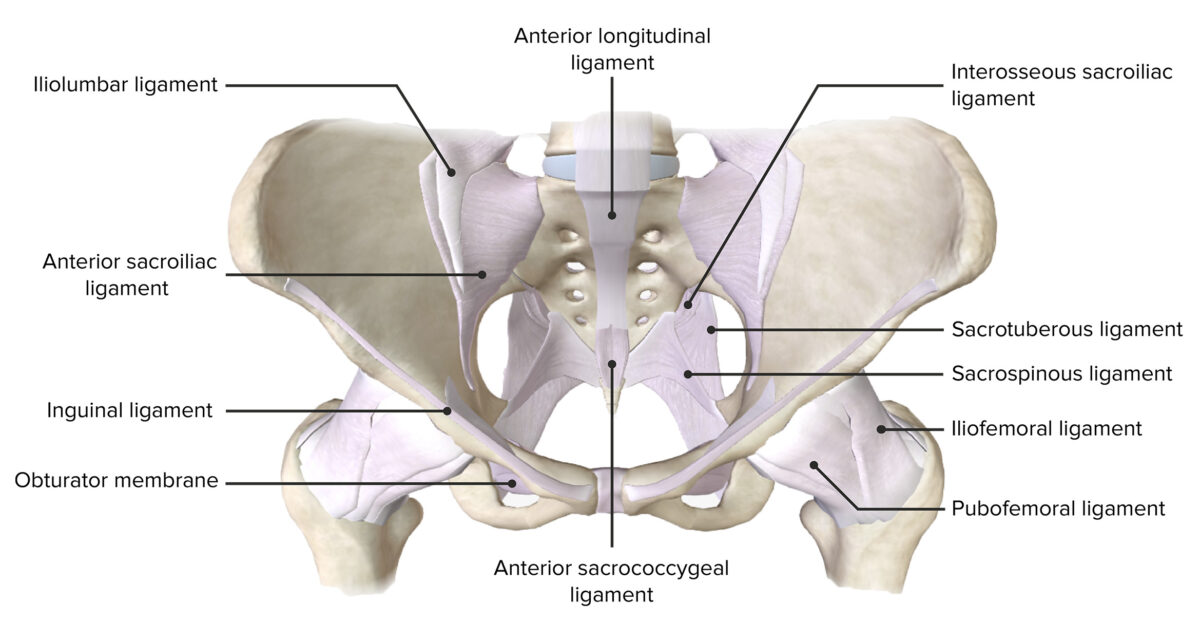
Anterior view of the pelvis, featuring the supporting ligaments of the joints of the pelvic girdle
Image by BioDigital, edited by Lecturio.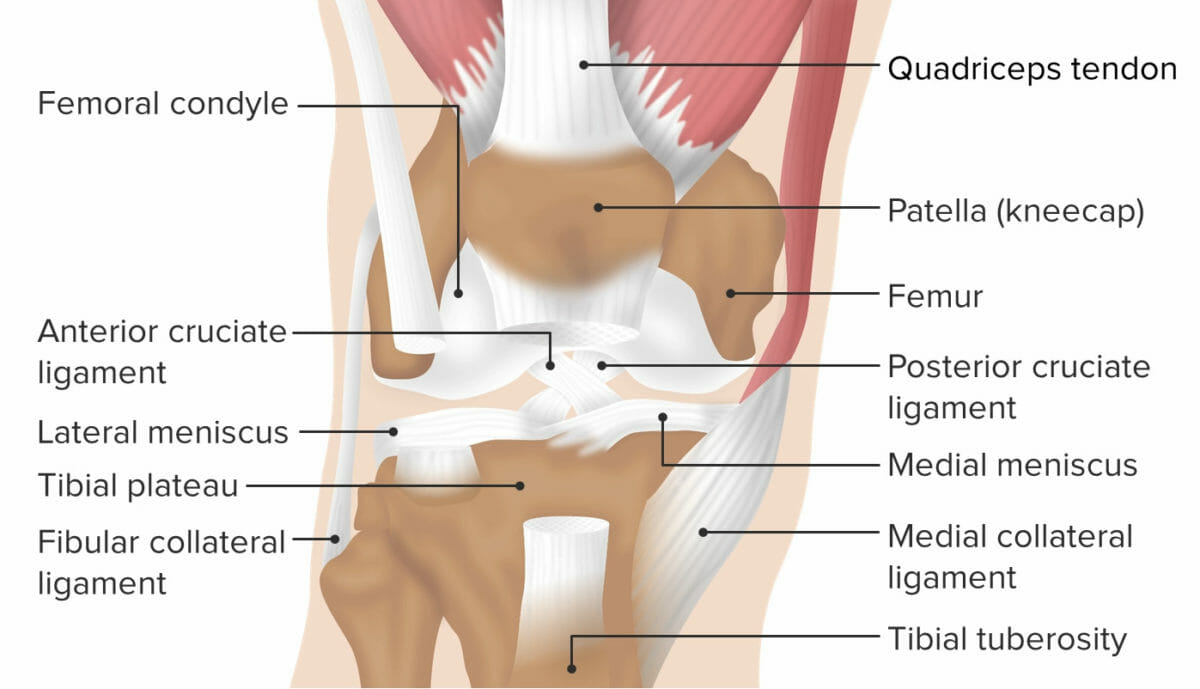
Knee ligaments tested using special tests to ensure stability
Image by Lecturio.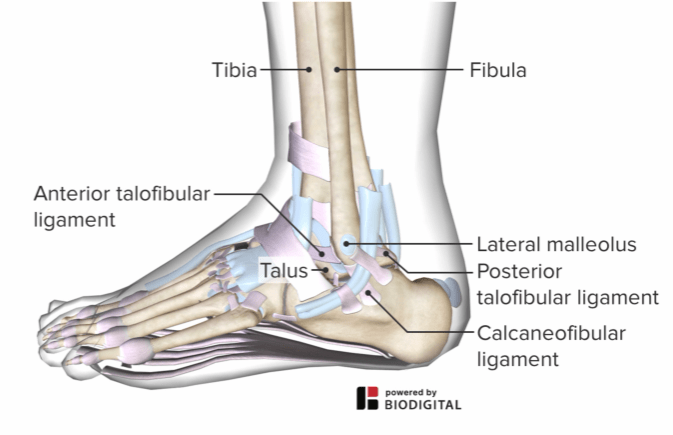
Lateral ankle showing the ligaments of the ankle joint that stabilize the joint
Image by BioDigital, edited by Lecturio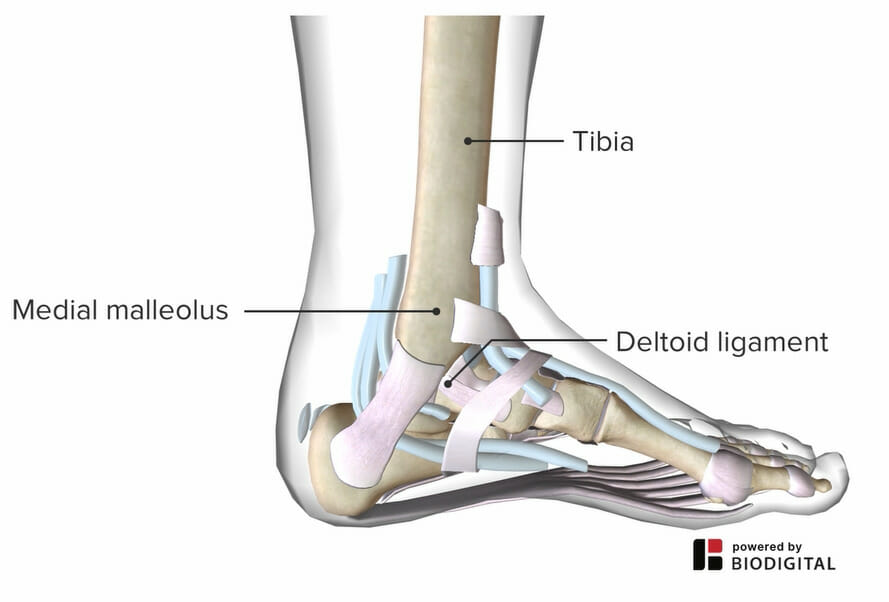
Ligaments supporting the medial aspect of the ankle joint
Image by BioDigital, edited by Lecturio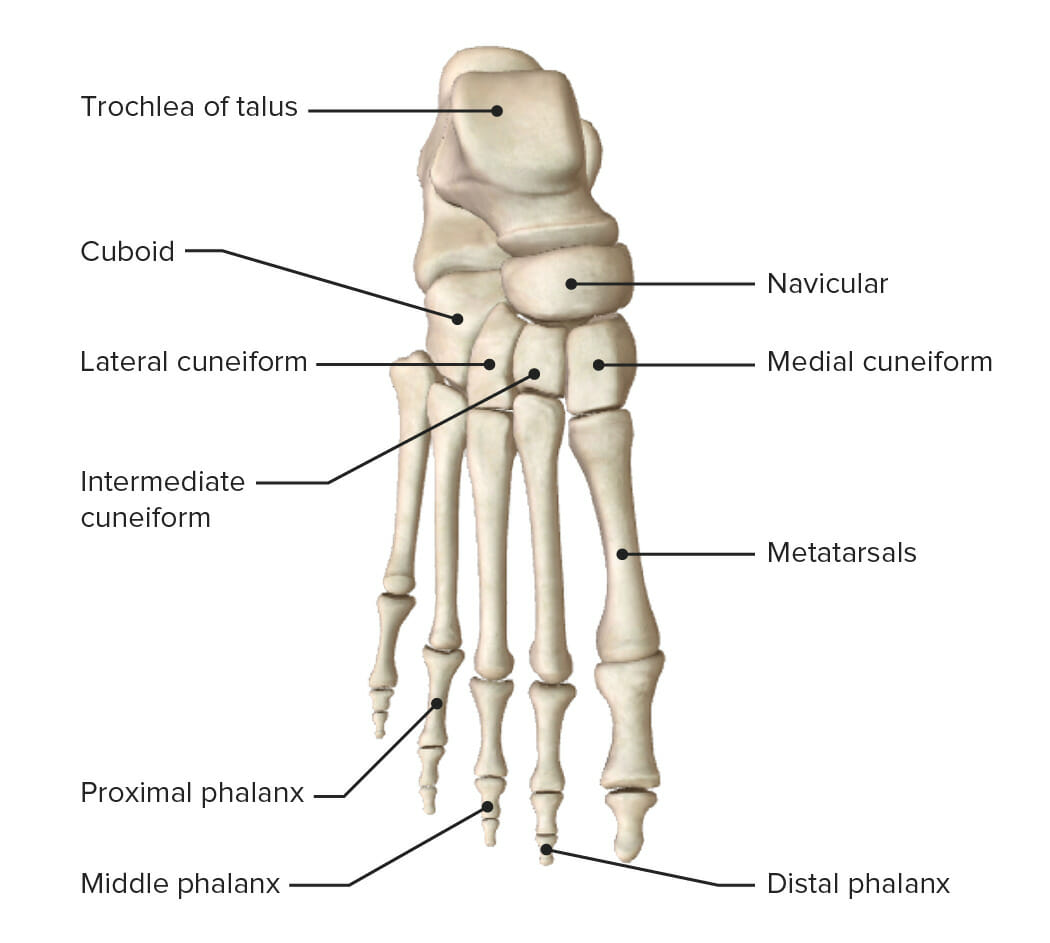
Superior view of the right foot featuring the bones of the foot and the tarsus
Image by Lecturio.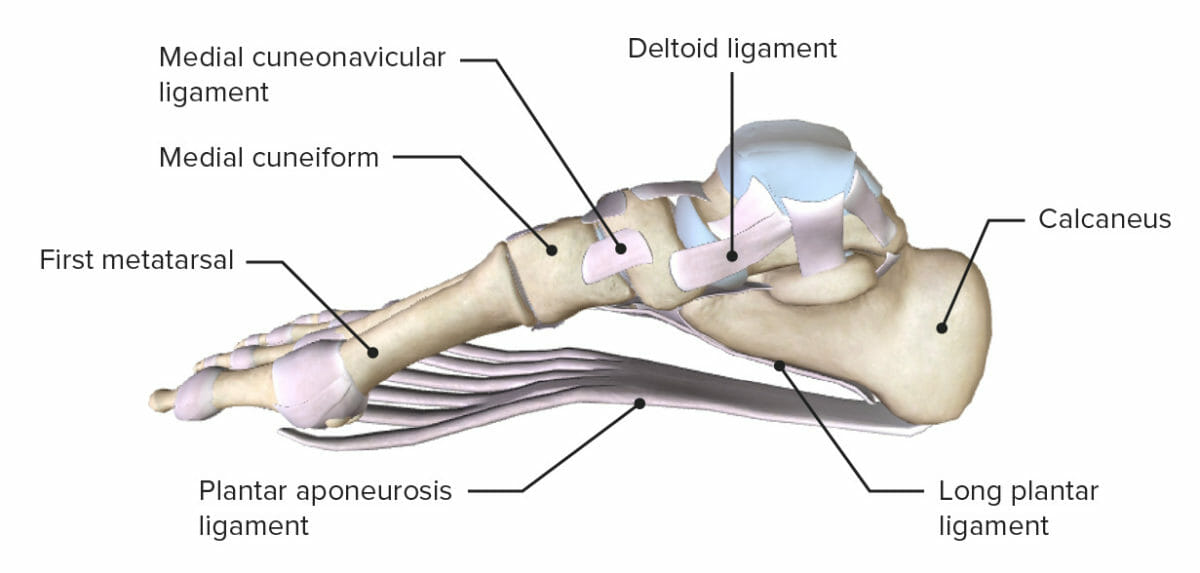
Medial view of the foot featuring the arches of the foot
Image by Lecturio.“Hip pain Pain An unpleasant sensation induced by noxious stimuli which are detected by nerve endings of nociceptive neurons. Pain: Types and Pathways,” as referred to by the layperson, is a common term that may be due to pathology in numerous structures. This pain Pain An unpleasant sensation induced by noxious stimuli which are detected by nerve endings of nociceptive neurons. Pain: Types and Pathways should be further clarified by the examiner as to whether the pain Pain An unpleasant sensation induced by noxious stimuli which are detected by nerve endings of nociceptive neurons. Pain: Types and Pathways is:
Low lumbar spine Spine The human spine, or vertebral column, is the most important anatomical and functional axis of the human body. It consists of 7 cervical vertebrae, 12 thoracic vertebrae, and 5 lumbar vertebrae and is limited cranially by the skull and caudally by the sacrum. Vertebral Column: Anatomy/lumbosacral spine Spine The human spine, or vertebral column, is the most important anatomical and functional axis of the human body. It consists of 7 cervical vertebrae, 12 thoracic vertebrae, and 5 lumbar vertebrae and is limited cranially by the skull and caudally by the sacrum. Vertebral Column: Anatomy:
Sacroiliac joint Sacroiliac Joint The immovable joint formed by the lateral surfaces of the sacrum and ilium. Pelvis: Anatomy:
Ischial tuberosity Ischial Tuberosity Chronic Apophyseal Injury/ ischial bursa Ischial bursa Hip Joint: Anatomy:
Piriformis Piriformis Vagina, Vulva, and Pelvic Floor: Anatomy muscle/ piriformis Piriformis Vagina, Vulva, and Pelvic Floor: Anatomy syndrome:
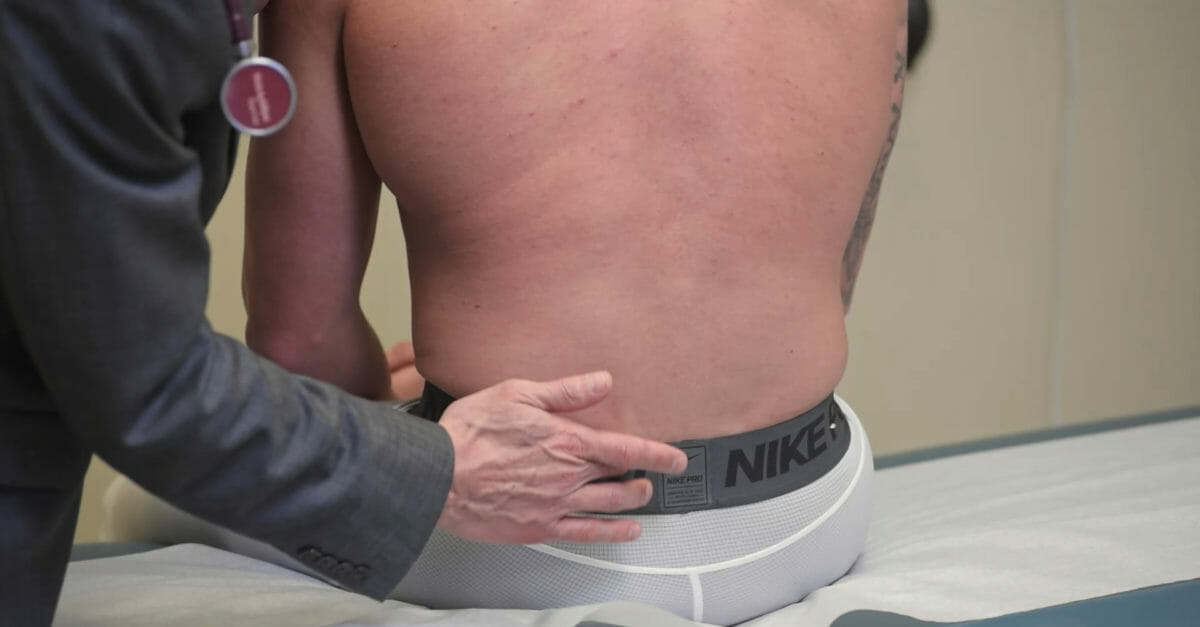
Palpation of the posterior superior iliac spine:
This palpation is useful for identifying a bony landmark. In the Fortin finger point test, the individual is asked to point at the source of their pain. Localization of the individual’s fingertip near the posterior superior iliac spine is suggestive of SI joint disease. The posterior superior iliac spine is also commonly tender to palpation in SI joint disorders.
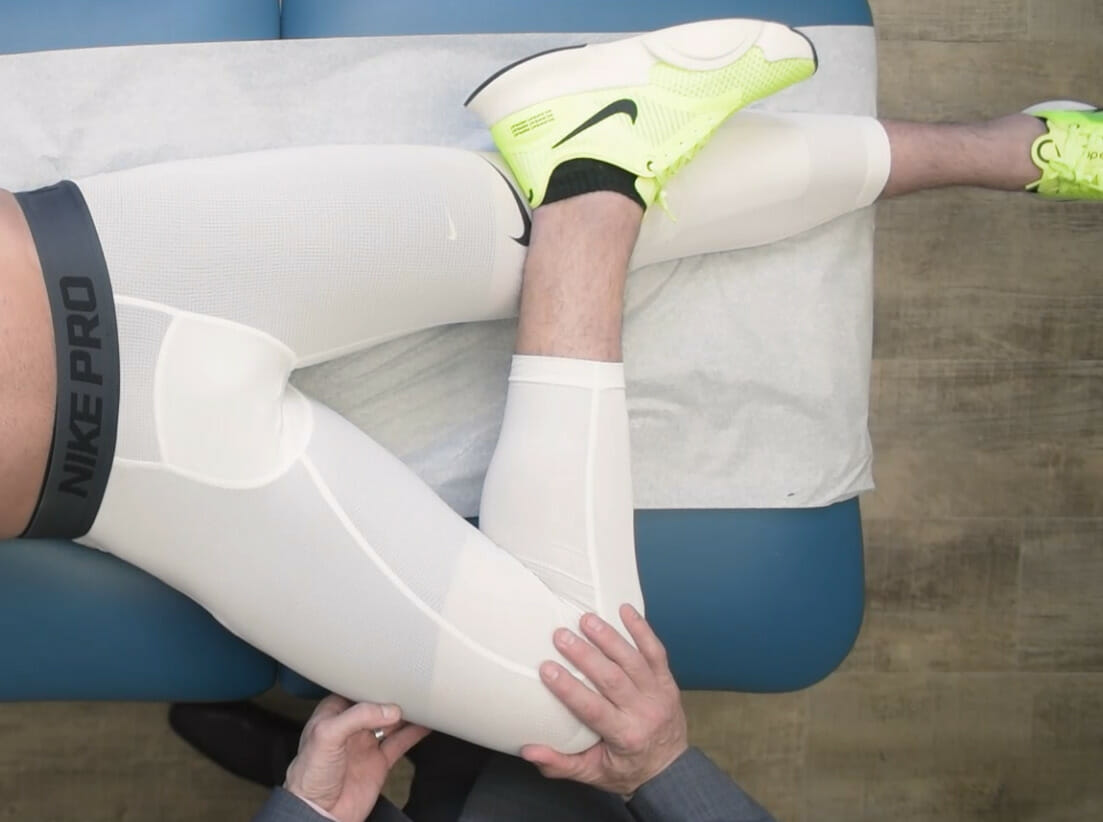
The figure 4, or FABER, test:
With the individual in the supine position, the affected hip is carried into passive Flexion, ABduction, and External Rotation by the examiner, followed by a downward force applied by the examiner. This force causes stress against the SI joint(s). This provocative maneuver is designed to reproduce posterior hip pain and is associated with SI joint pathology.
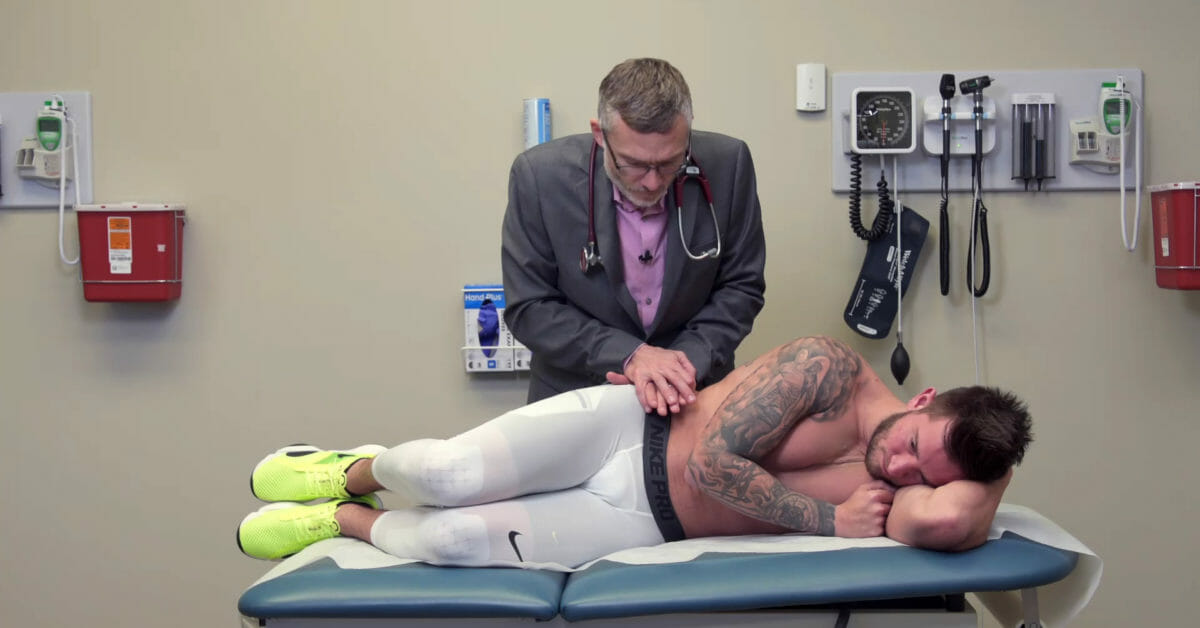
The pelvic compression test:
With the individual in the lateral decubitus position, the examiner compresses the innominates by applying a downward force through the anterior superior iliac spine. This force causes stress against the SI joint(s). This provocative maneuver is designed to reproduce posterior hip pain and is associated with SI joint pathology.
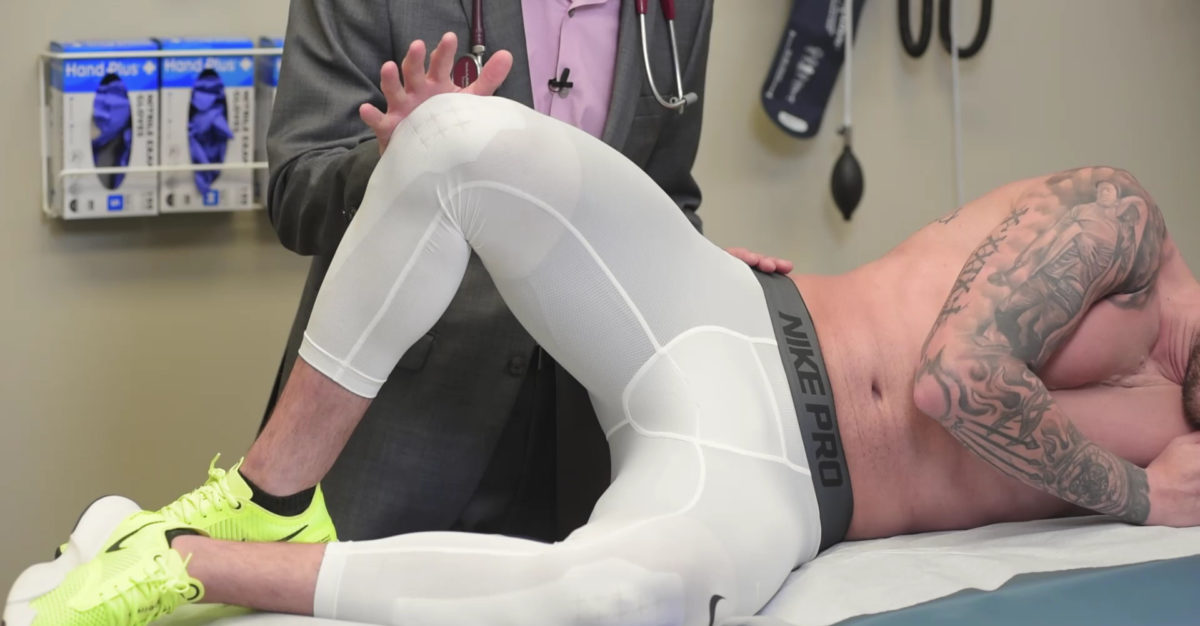
Active piriformis test:
With the individual in the lateral decubitus position with the hip and knee flexed, the examiner applies a medial force against the lateral aspect of the knee to induce adduction of the hip against the individual’s active effort to abduct (the piriformis is an abductor and external rotator of the hip when the hip is flexed). This force causes the piriformis to contract. This provocative maneuver is designed to reproduce posterior hip pain and is associated with piriformis pathology or irritation of the sciatic nerve (pseudosciatica) as it passes under (or through) the piriformis.
Proximal iliotibial (IT) band/tensor fascia lata Fascia lata Femoral Region and Hernias: Anatomy:
Trochanteric bursitis:

The Ober test:
With the individual in the lateral decubitus position (affected side up) and the hip in the neutral position, the examiner passively carries the hip into abduction (shortening the IT band) by lifting at the knee and then letting it fall. In the absence of IT band (or tensor fascia lata) pathology, the knee will fall to its original position free of resistance. If IT band pathology is present, the knee may fall slowly or may stop midway owing to contracture(s) of the IT band.
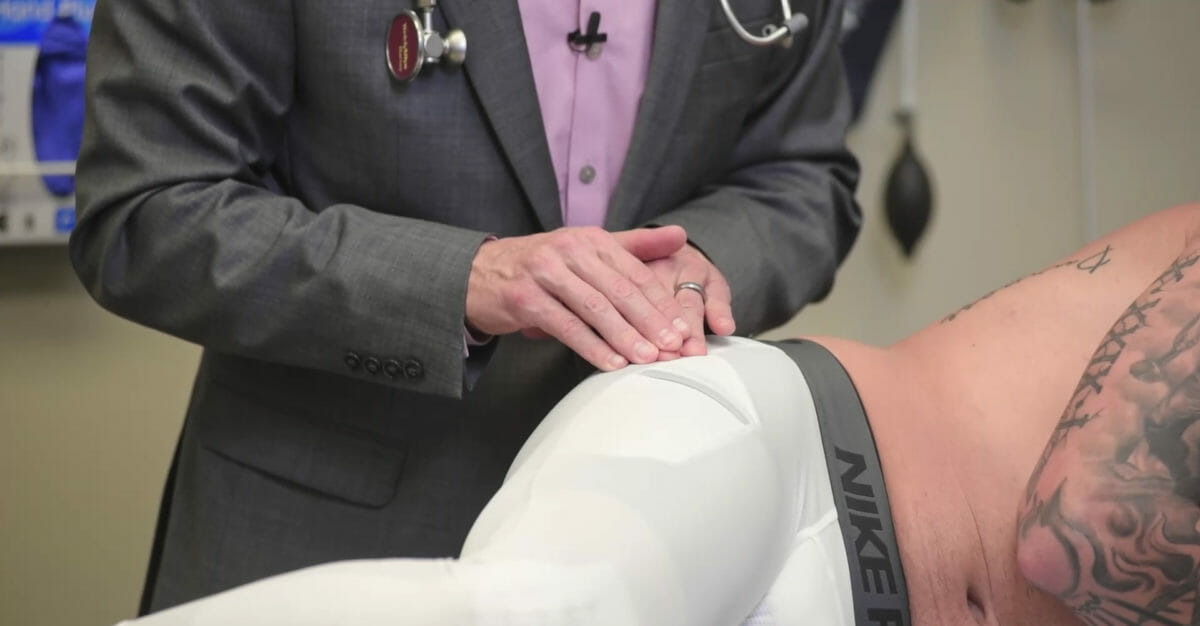
Palpation and provocation of the greater trochanter:
With the individual in the lateral decubitus position (affected side up), the examiner locates the greater trochanter and applies a downward provocative force. This force causes compression of the trochanteric bursa overlying the greater trochanter. This provocative maneuver is designed to reproduce lateral hip pain and is associated with pathology of the trochanteric bursa.
Image by Lecturio.Femoroacetabular joint:
Hip flexors/iliopsoas syndrome:
Lateral femoral cutaneous nerve entrapment ( meralgia paresthetica Meralgia Paresthetica Mononeuropathy and Plexopathy):
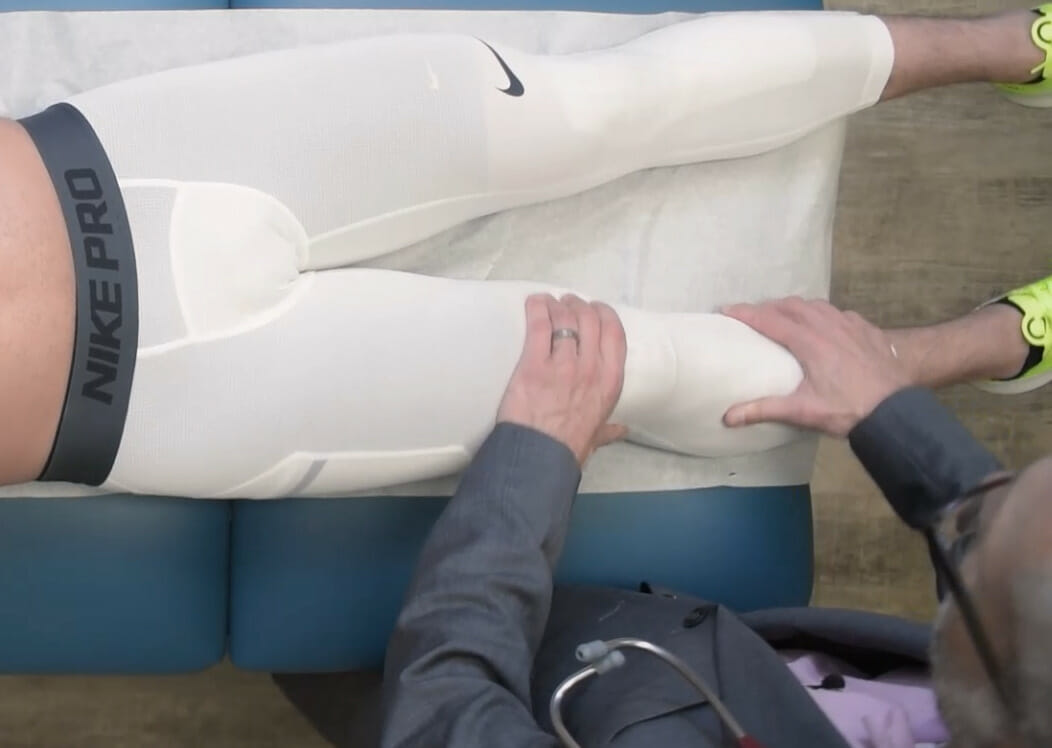
Log roll test:
With the individual in the supine position, the femur is passively rotated internally and externally within the acetabulum. This provocative maneuver is designed to reproduce pain in the anterior hip (generally with internal rotation) and is associated with femoroacetabular joint pathology.
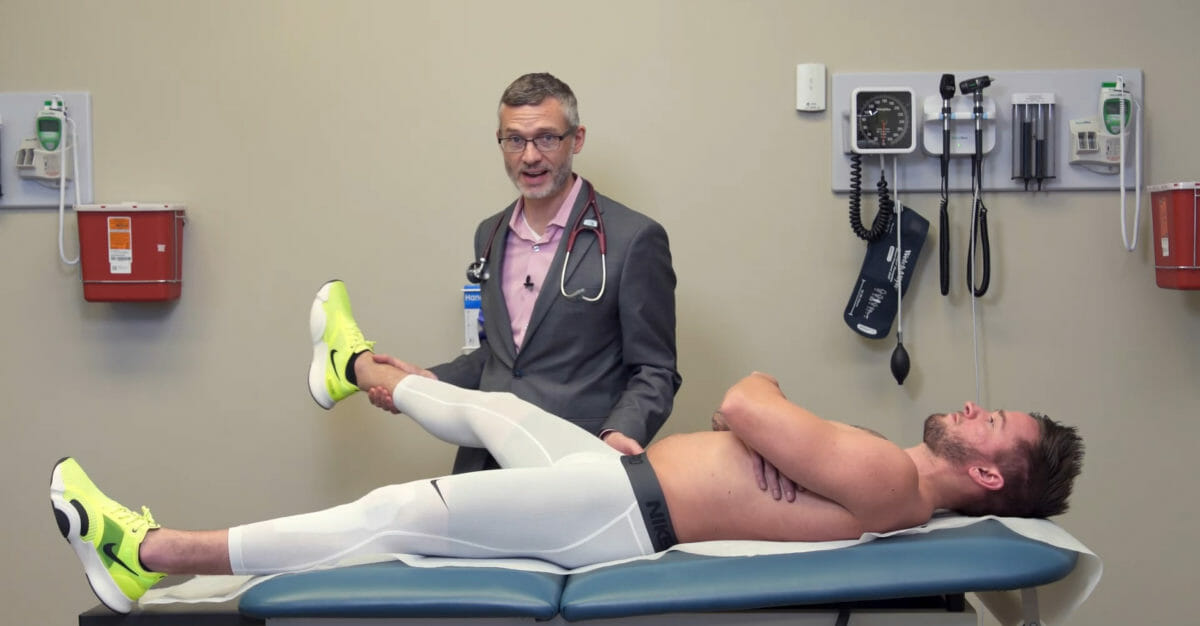
Hip abduction and adduction:
With the individual in the supine position, the examiner passively carries the hip into abduction and adduction. This provocative maneuver is designed to reproduce pain in the anterior hip and is associated with femoroacetabular joint pathology.

Resisted flexion of the hip:
With the individual in the supine position, the examiner places a downward force against the individual’s distal femur while the individual resists by actively contracting the hip flexors. This provocative maneuver is designed to reproduce pain in the anterior hip and is associated with pathology of the hip flexors.

Percussion over the lateral femoral cutaneous nerve at its exit point from the anterior abdominal wall just medial to the anterior superior iliac spine:
This provocative maneuver is designed to reproduce pain and/or paresthesia in the distribution of the nerve and is associated with nerve entrapment.
The femoral pulse can be palpated at the inguinal fold:
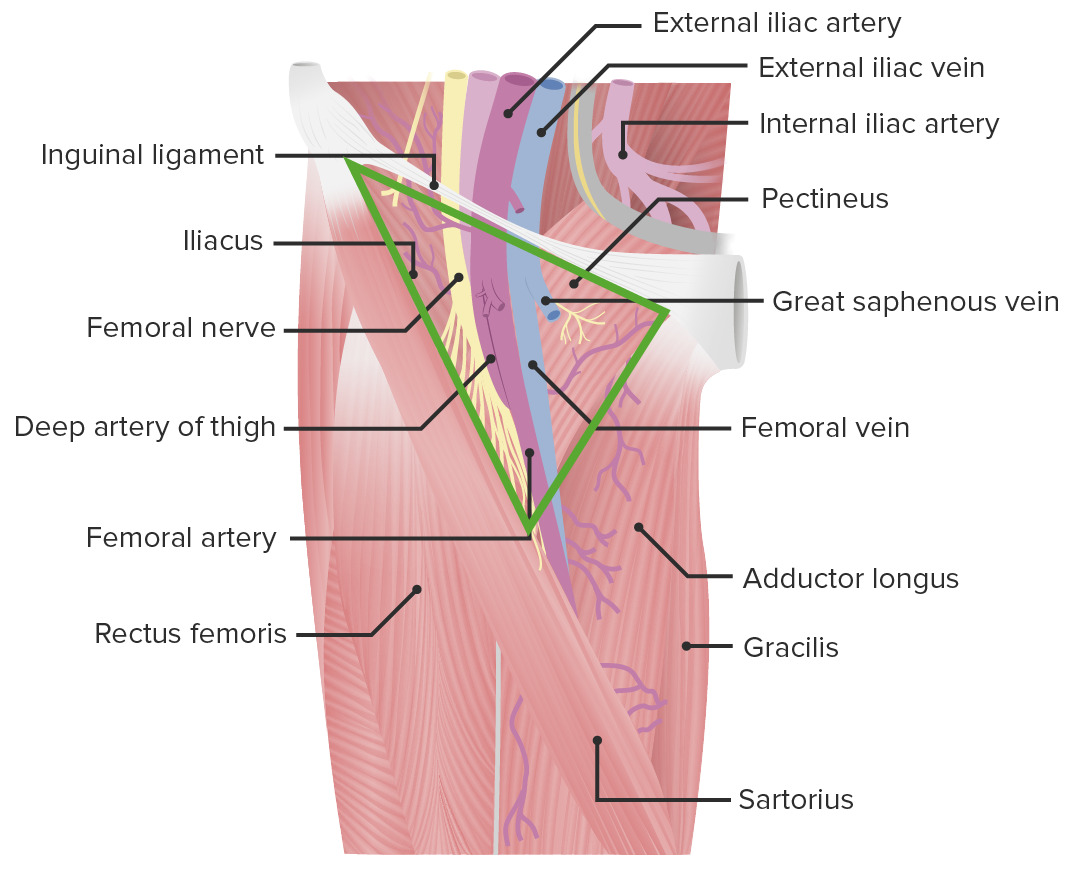
Anterior view of the thigh, featuring the femoral triangle with its borders and contents
Image by Lecturio.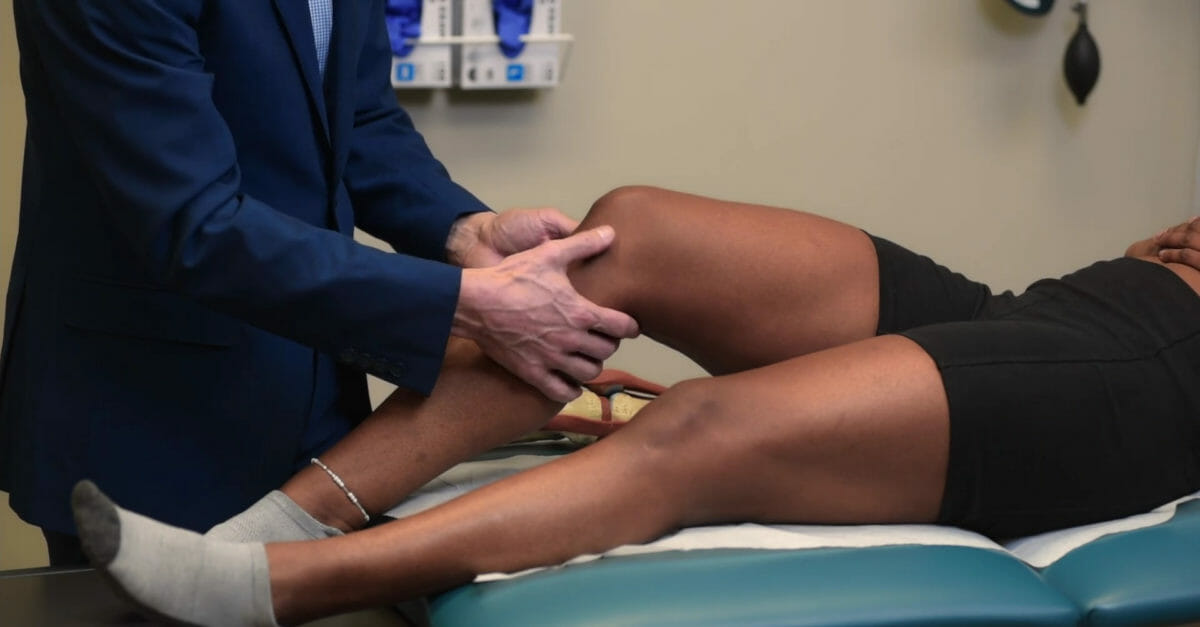
Palpation of the pes anserine bursa
Image by Lecturio.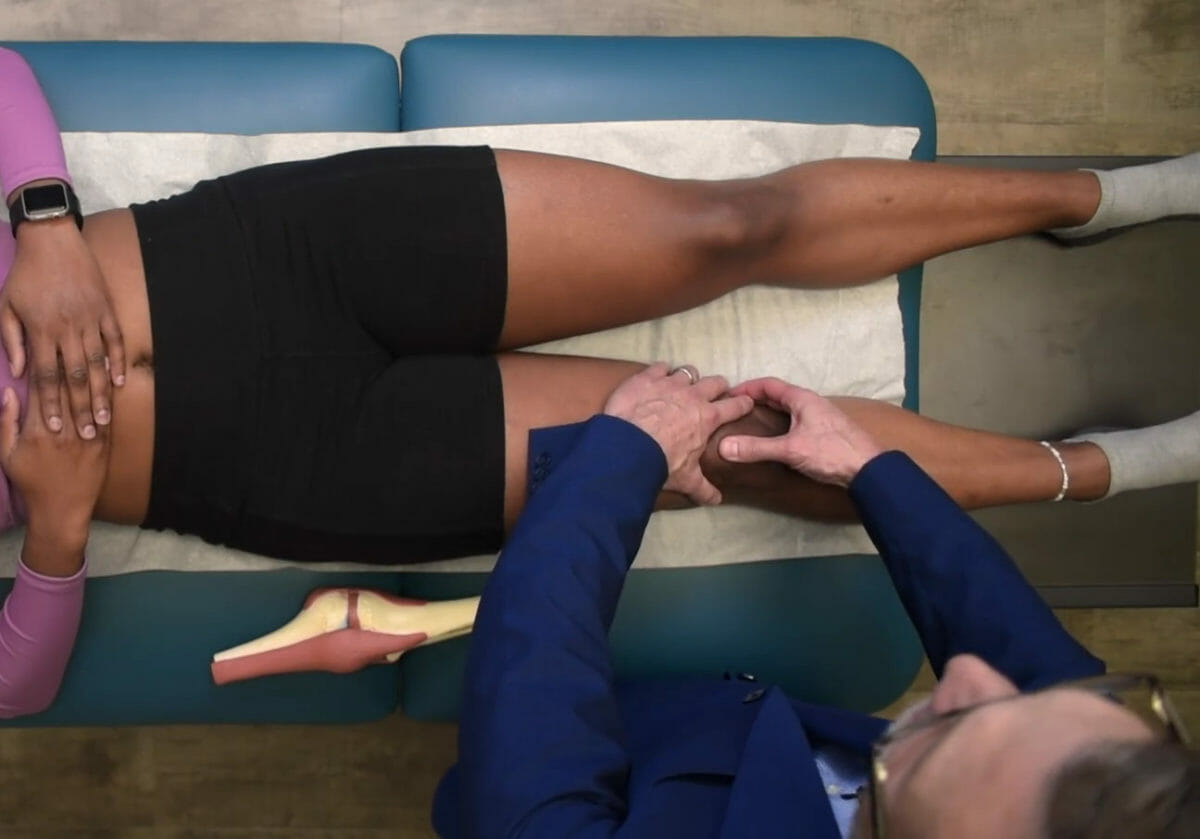
Patellar ballottement test
Image by Lecturio.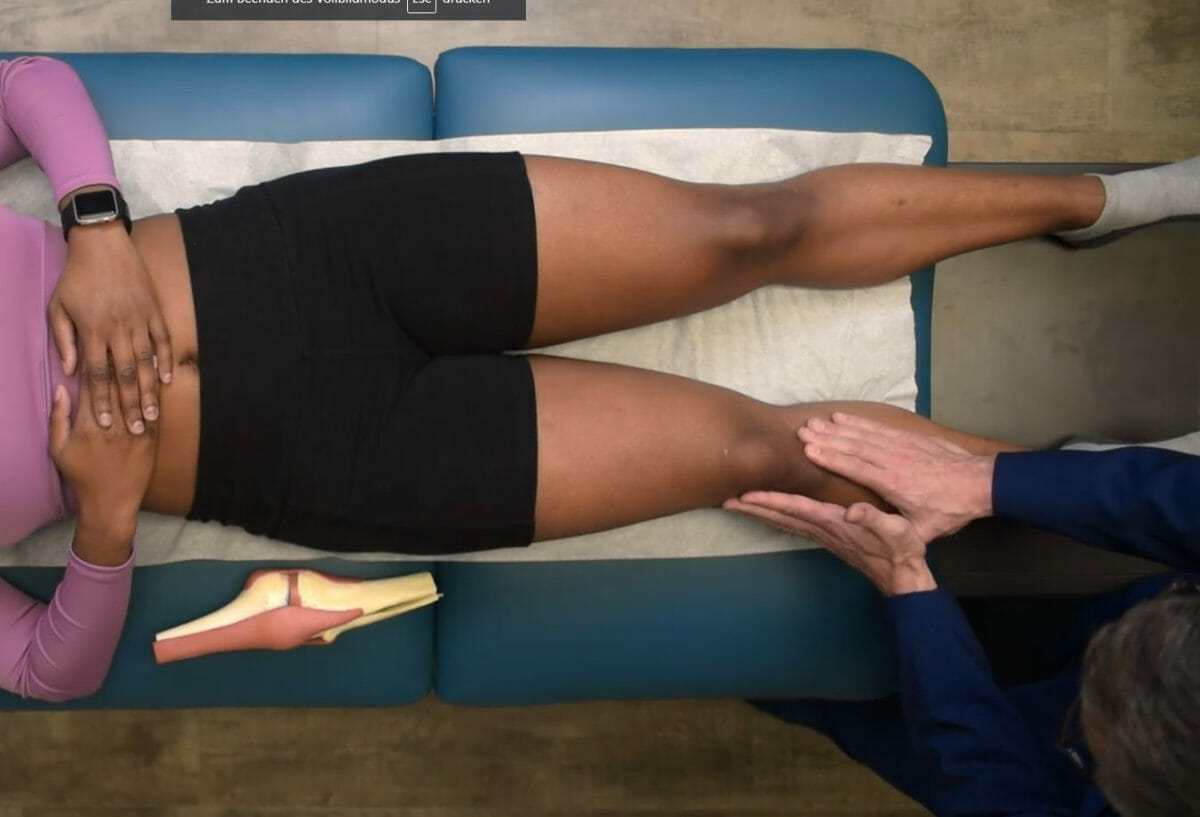
Bulge sign (ripple test)
Image by Lecturio.Always test the unaffected knee 1st and compare the 2 knees.
Collateral ligament stability:
Cruciate ligament stability:
Patellar stability: patellar apprehension test
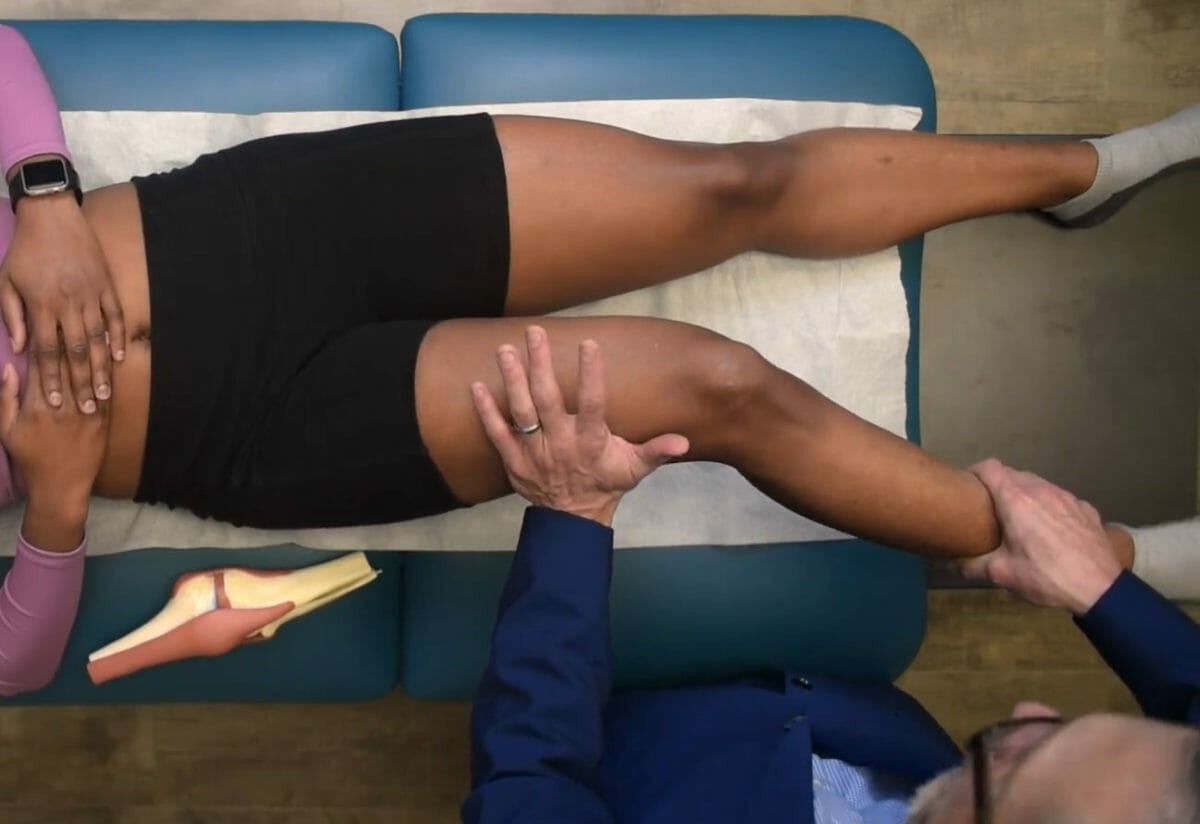
Valgus test to assess for medial collateral ligament stability at 30 degrees of flexion
Image by Lecturio.
Varus test for lateral collateral ligament stability, done at 30 degrees of flexion
Image by Lecturio.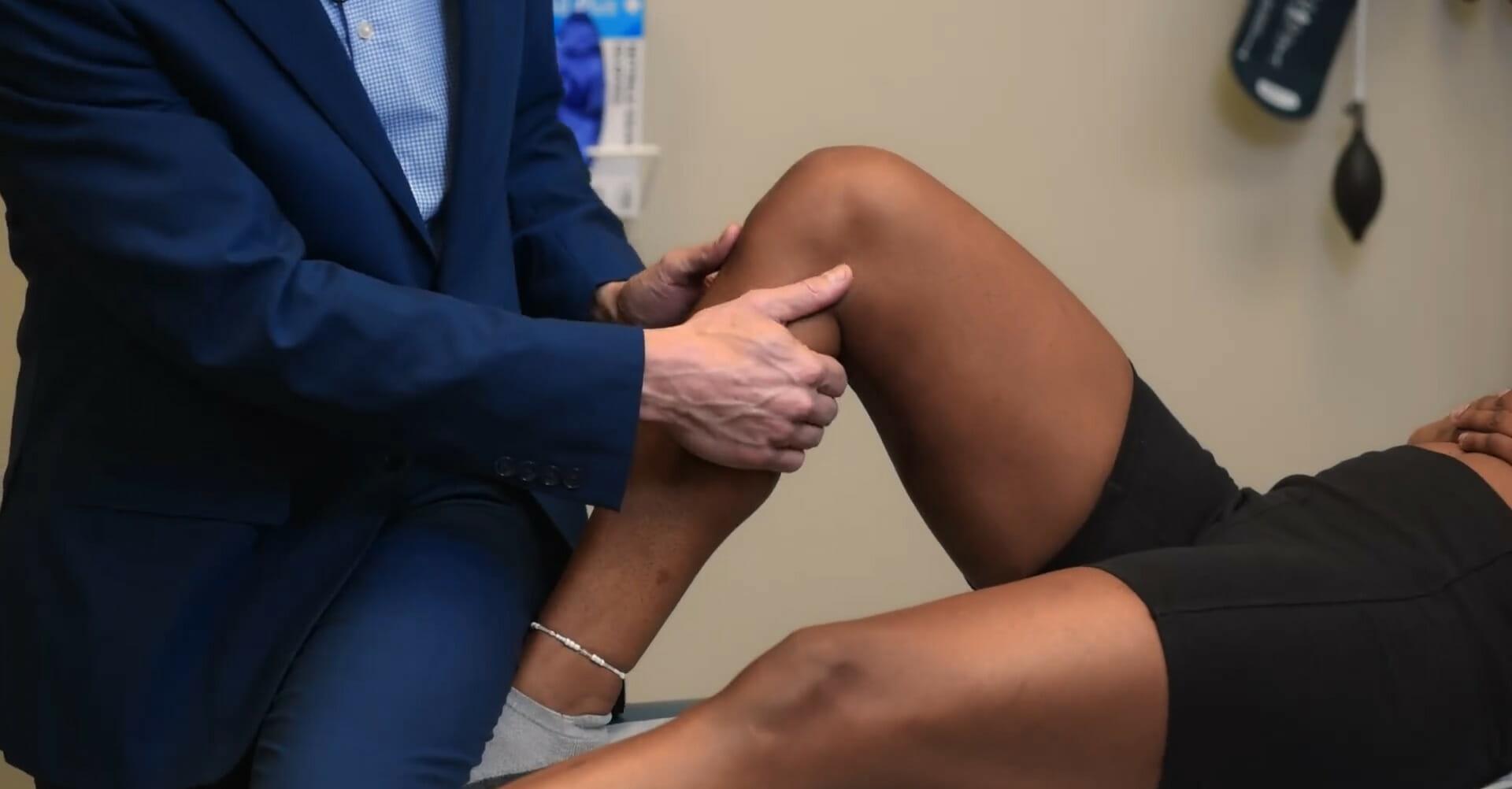
Anterior drawer test
Image by Lecturio.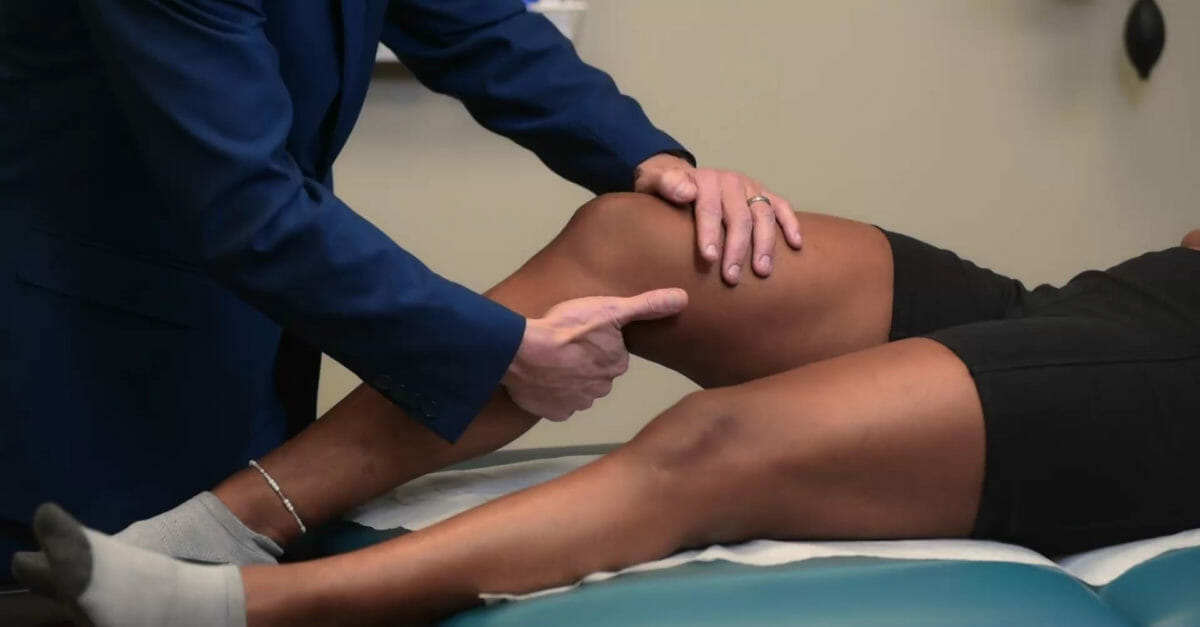
Lachman test for anterior cruciate ligament stability
Image by Lecturio.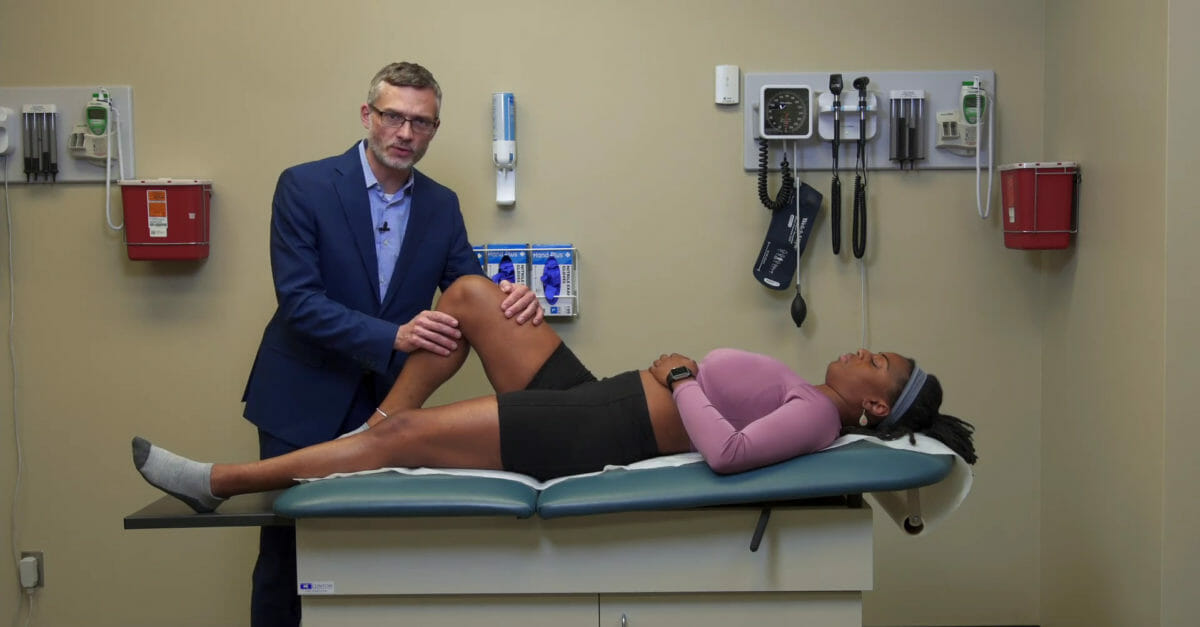
Posterior drawer test
Image by Lecturio.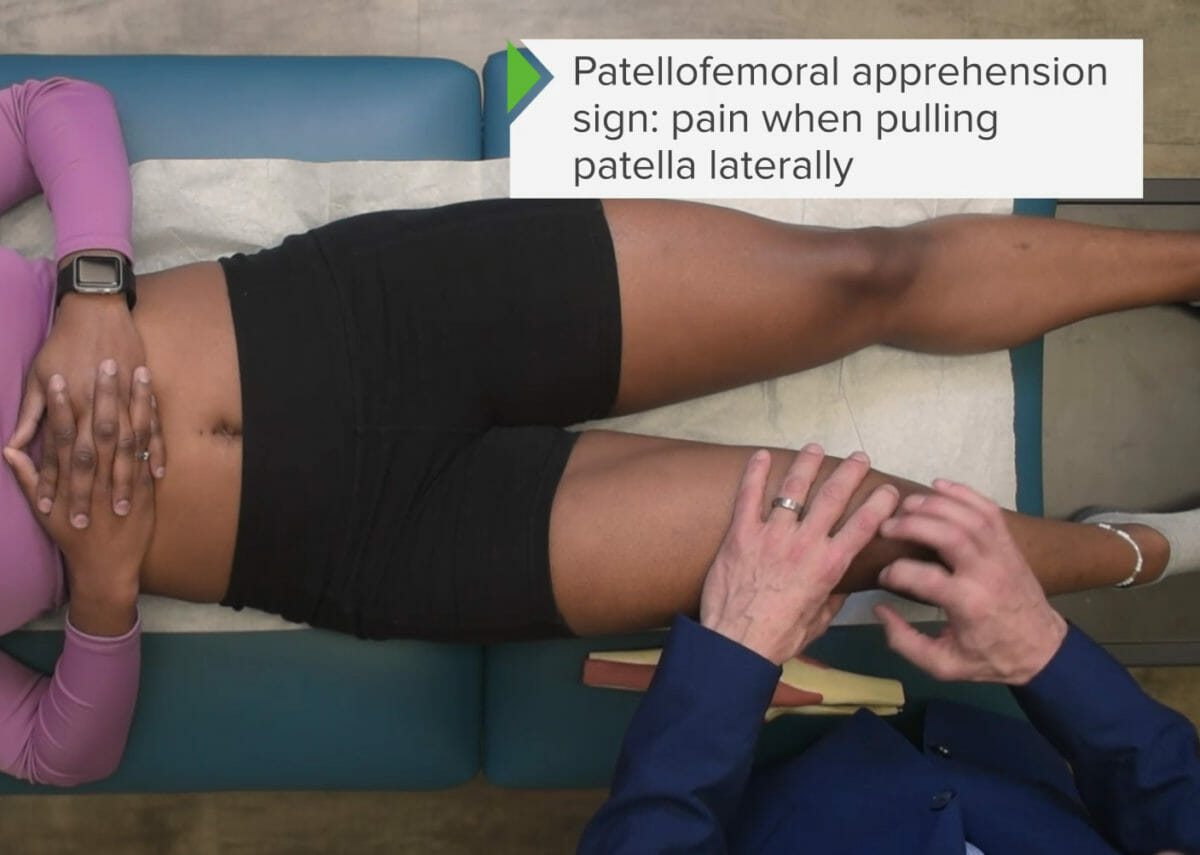
Patellar stability test
Image by Lecturio.Tests for meniscal tears:
Tests for iliotibial band Iliotibial band Thigh: Anatomy inflammation Inflammation Inflammation is a complex set of responses to infection and injury involving leukocytes as the principal cellular mediators in the body’s defense against pathogenic organisms. Inflammation is also seen as a response to tissue injury in the process of wound healing. The 5 cardinal signs of inflammation are pain, heat, redness, swelling, and loss of function. Inflammation:
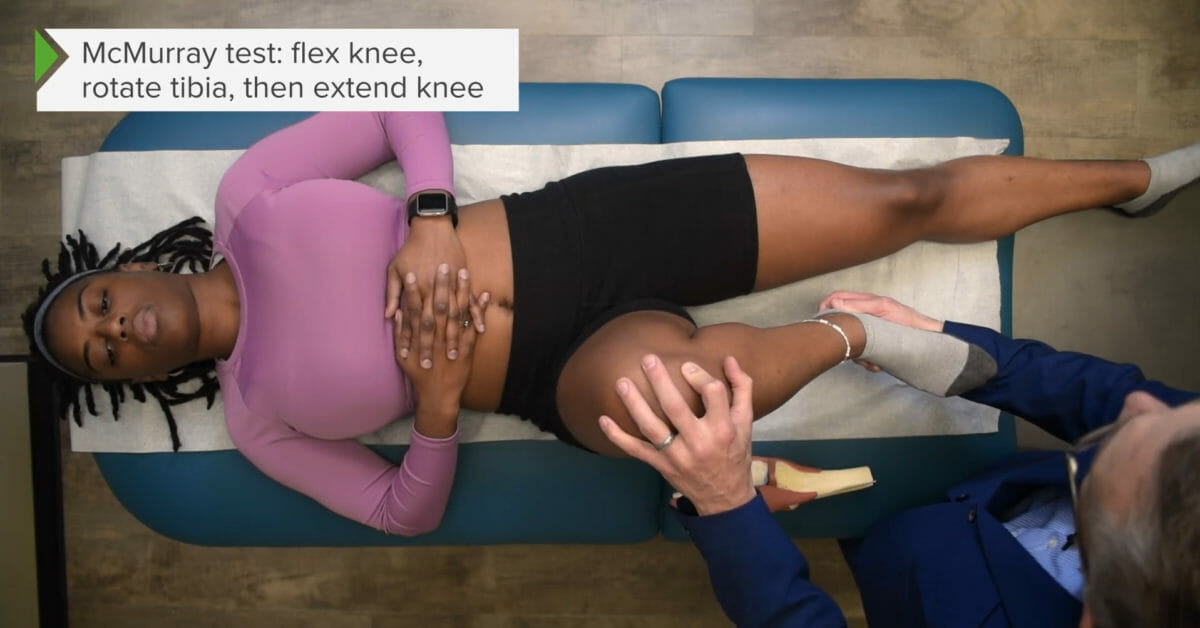
McMurray test:
External rotation with varus stress to test for medial meniscus tear
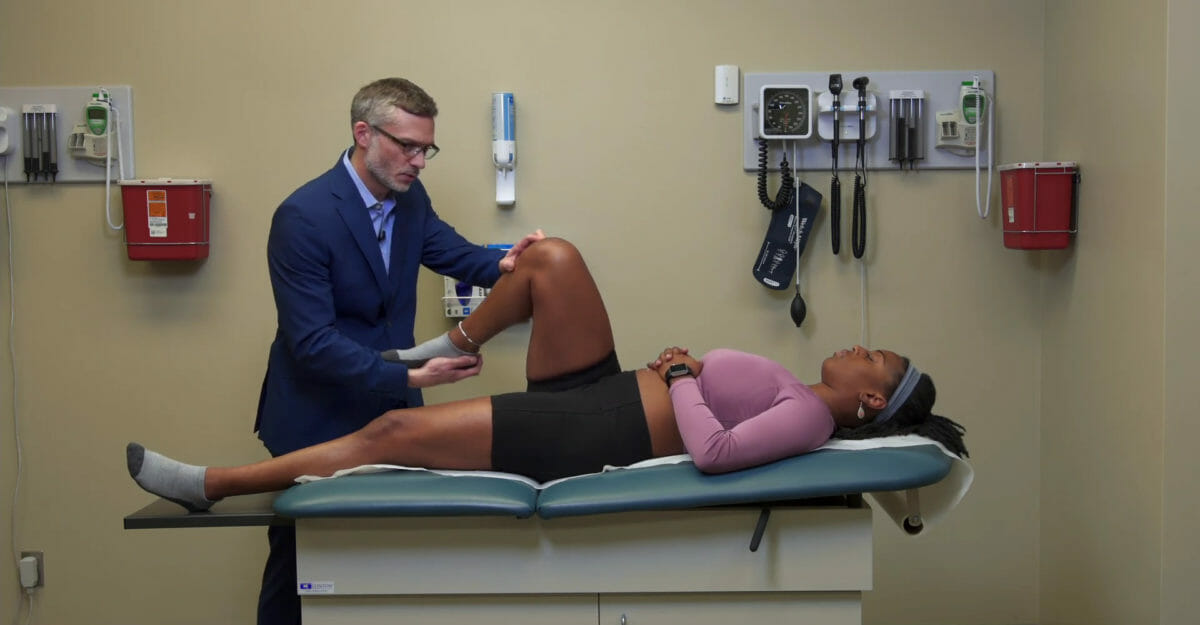
McMurray test:
Internal rotation with valgus stress to test for lateral meniscus tear
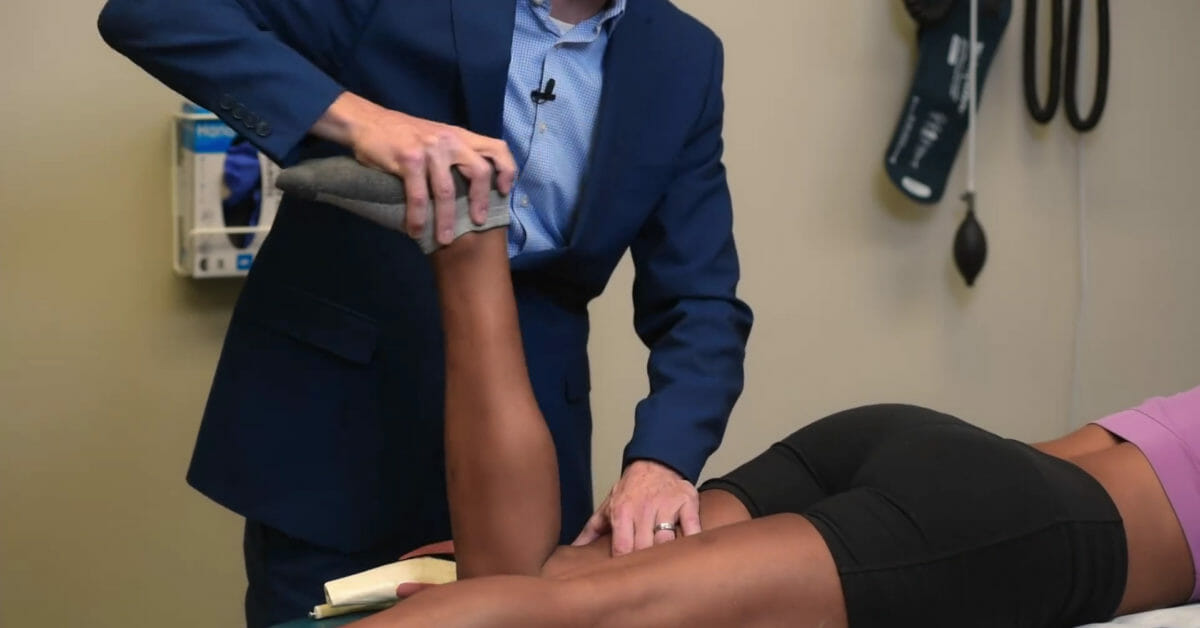
Apley test for meniscus tear
Image by Lecturio.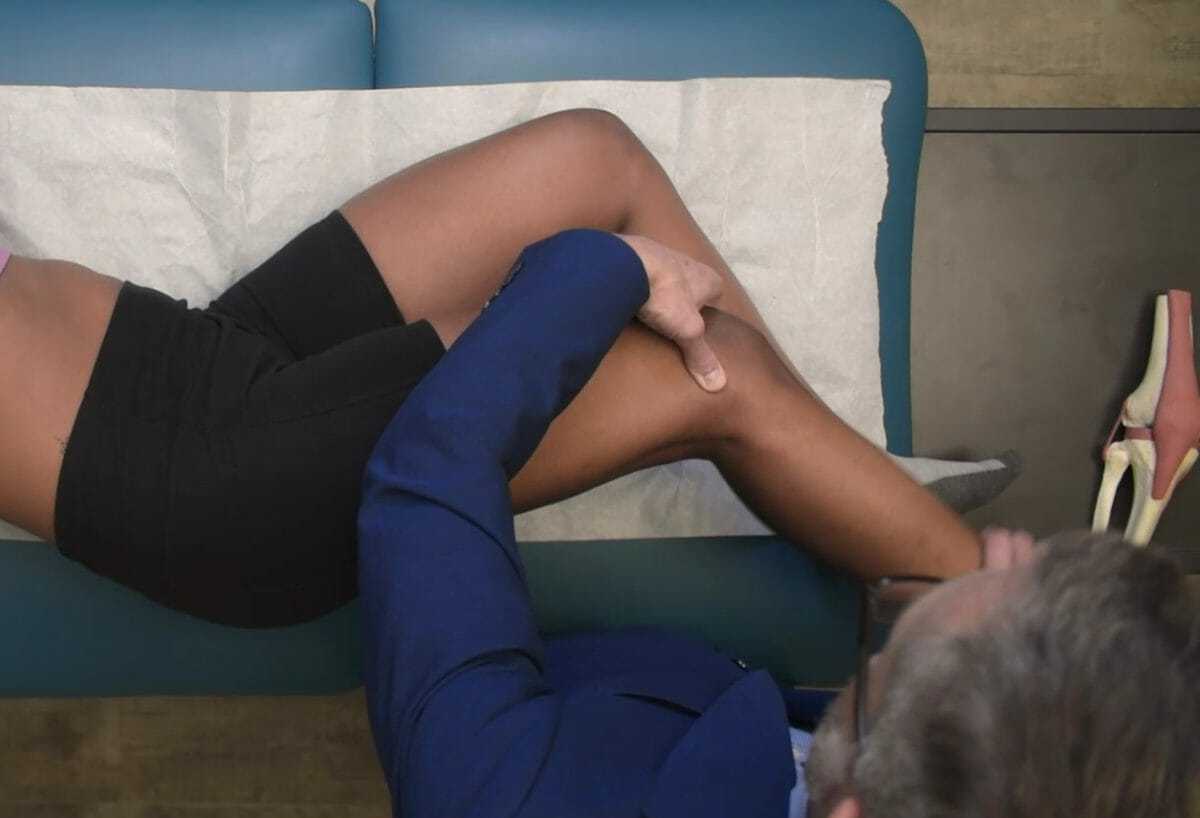
Noble test for iliotibial band syndrome
Image by Lecturio.The popliteal pulse Popliteal pulse Popliteal Fossa: Anatomy can be palpated at the popliteal fossa Popliteal fossa The popliteal fossa or the “knee pit” is a diamond-shaped, fat-filled, shallow depression on the posterior aspect of the knee joint. The popliteal fossa is located at the dorsal aspect of the knee and contains an increased number of lymph nodes as well as structures of the neurovascular system that travel from the thigh to the lower leg. Popliteal Fossa: Anatomy:
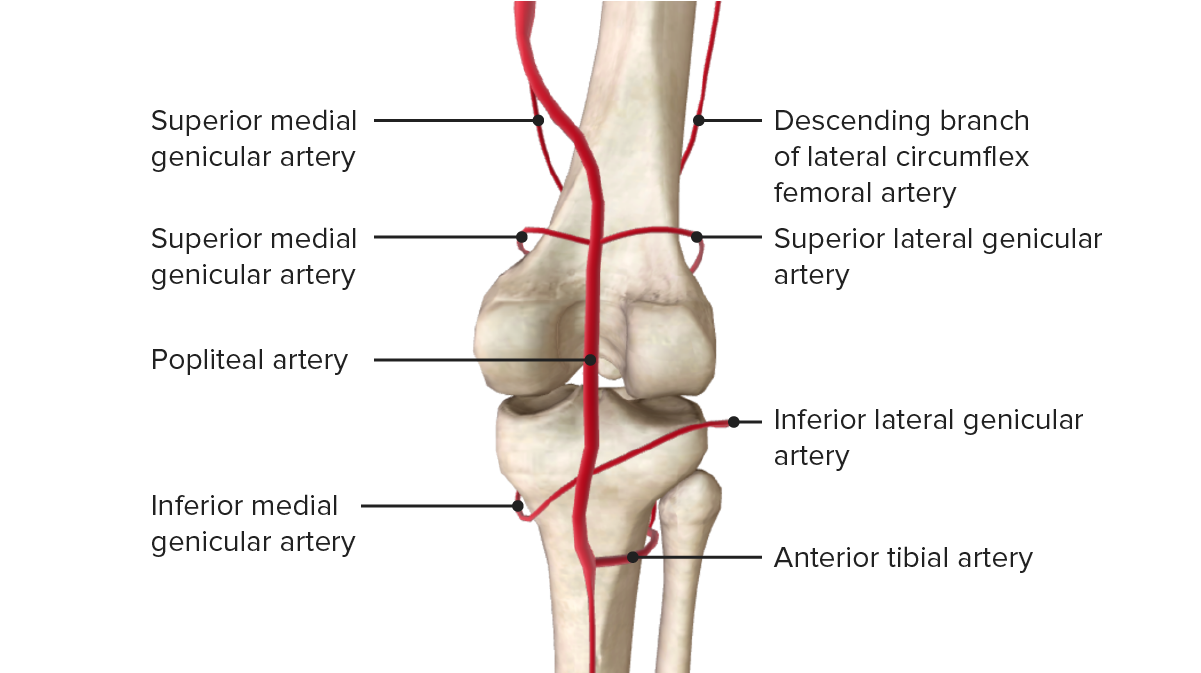
Posterior view of the vascular supply of the knee joint
Image by BioDigital, edited by LecturioPalpatory techniques of the following structures is performed, looking for tenderness, temperature, and swelling Swelling Inflammation:
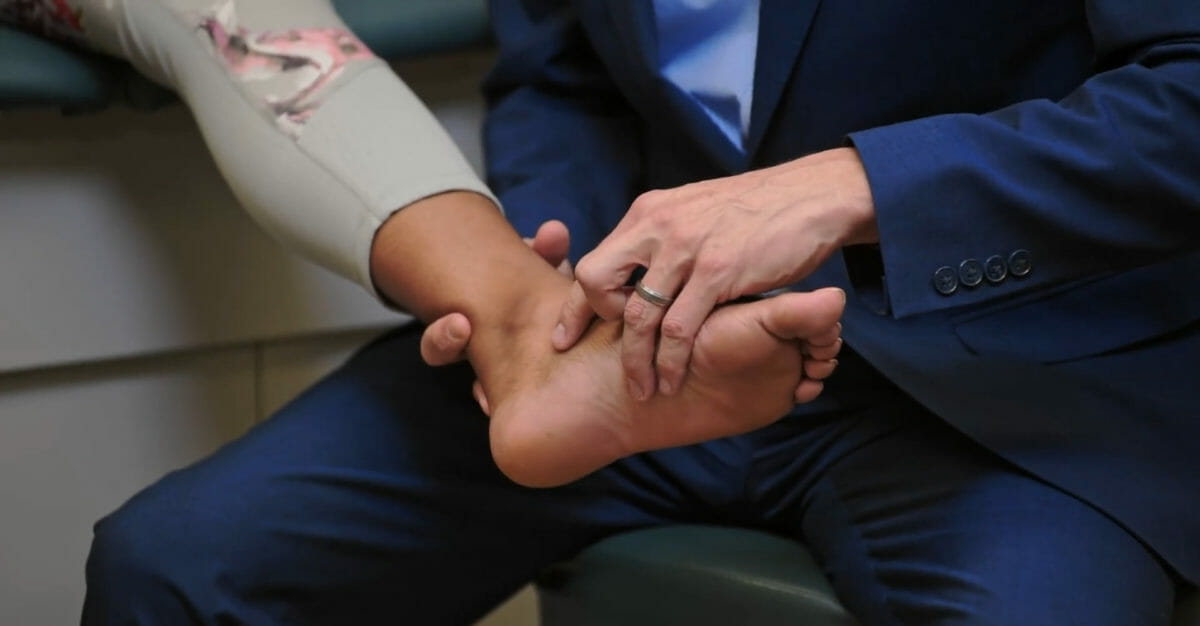
Palpation of the deltoid ligament
Image by Lecturio.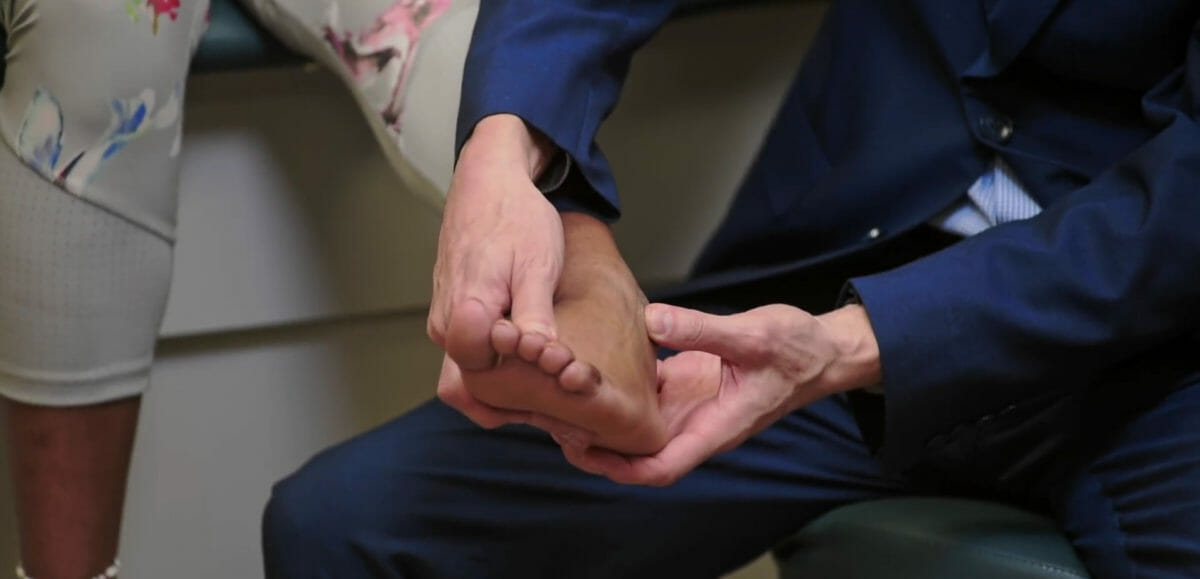
Palpation of the anterior talofibular ligament (ATFL) attachment
Image by Lecturio.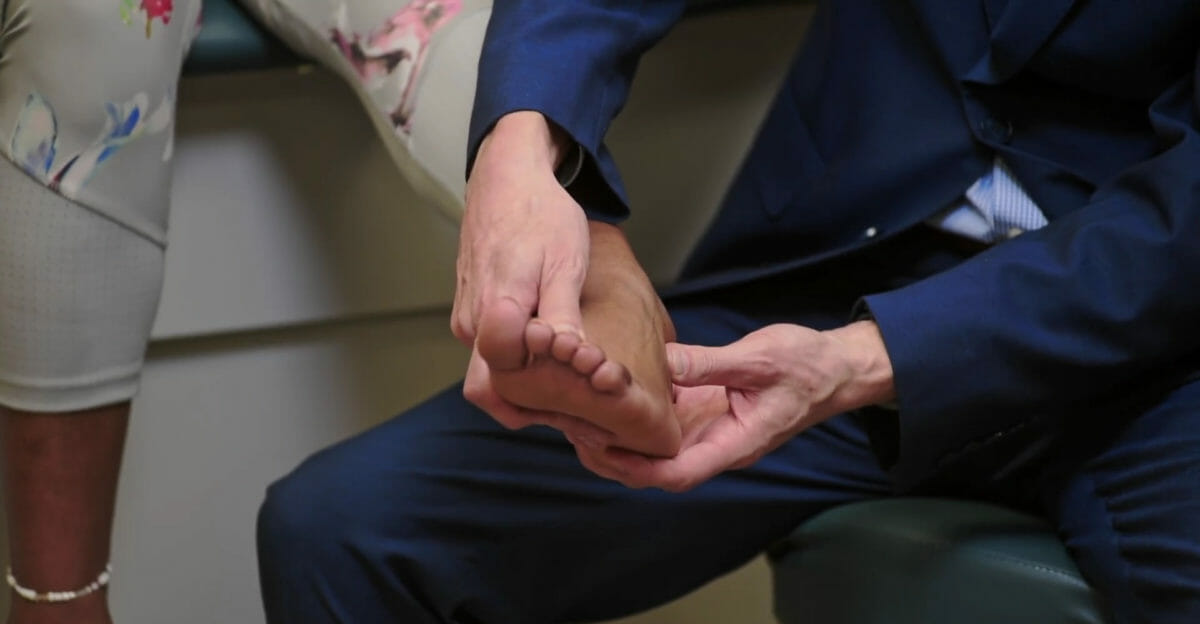
Palpation of the calcaneofibular ligament (CFL)
Image by Lecturio.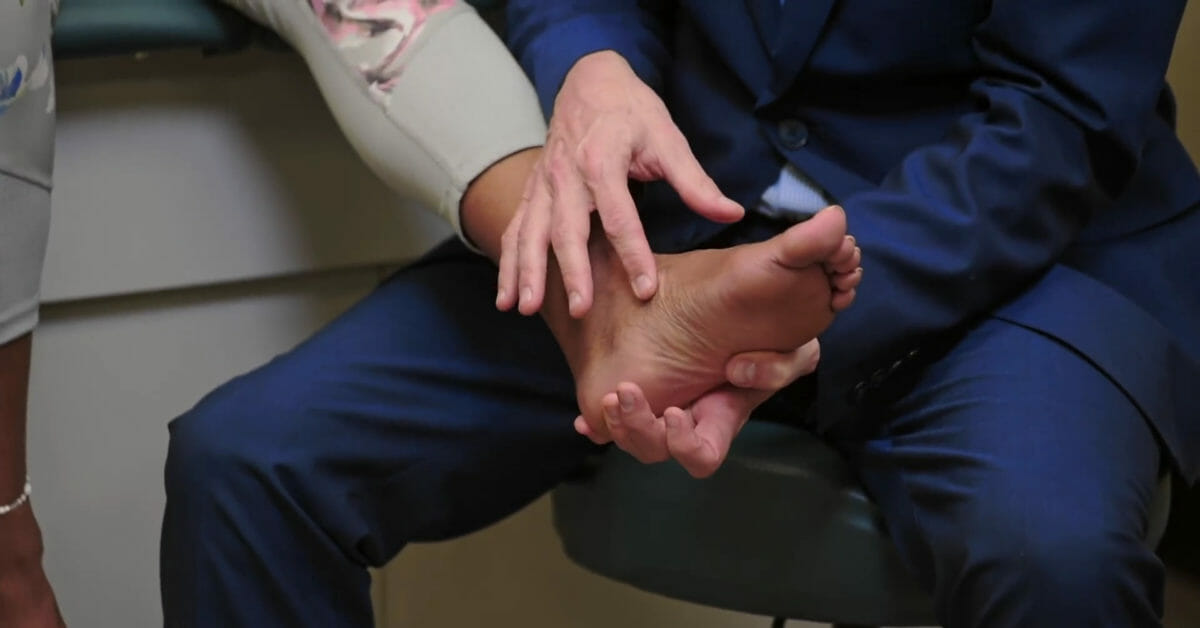
Palpation of the navicular bone
Image by Lecturio.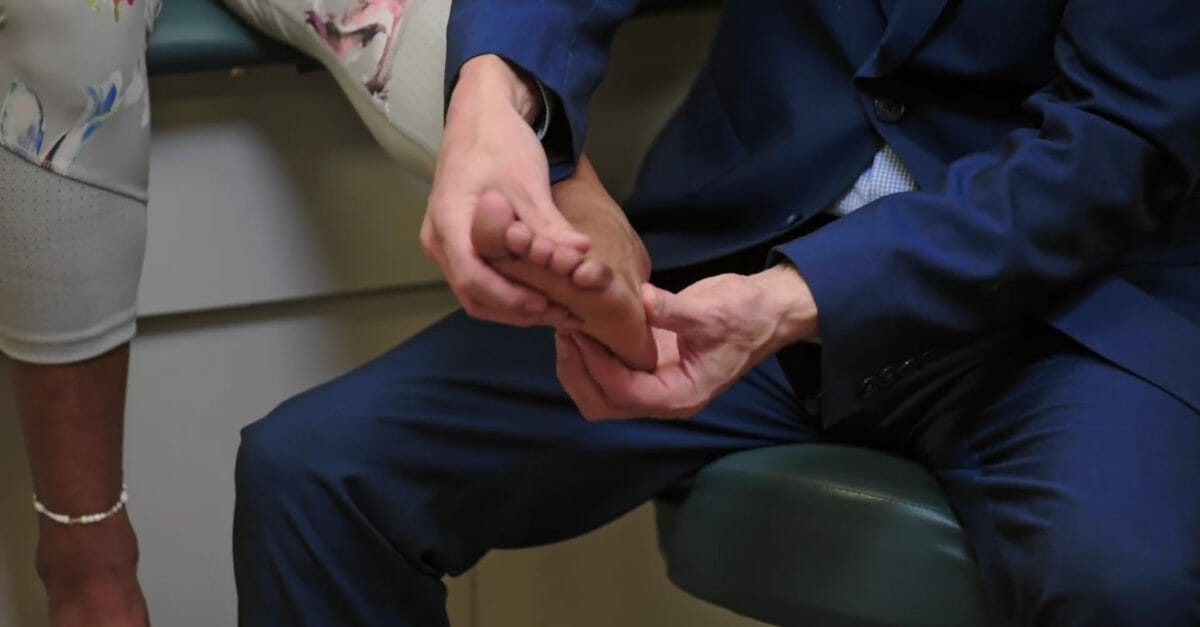
Palpation of the metatarsophalangeal joints
Image by Lecturio.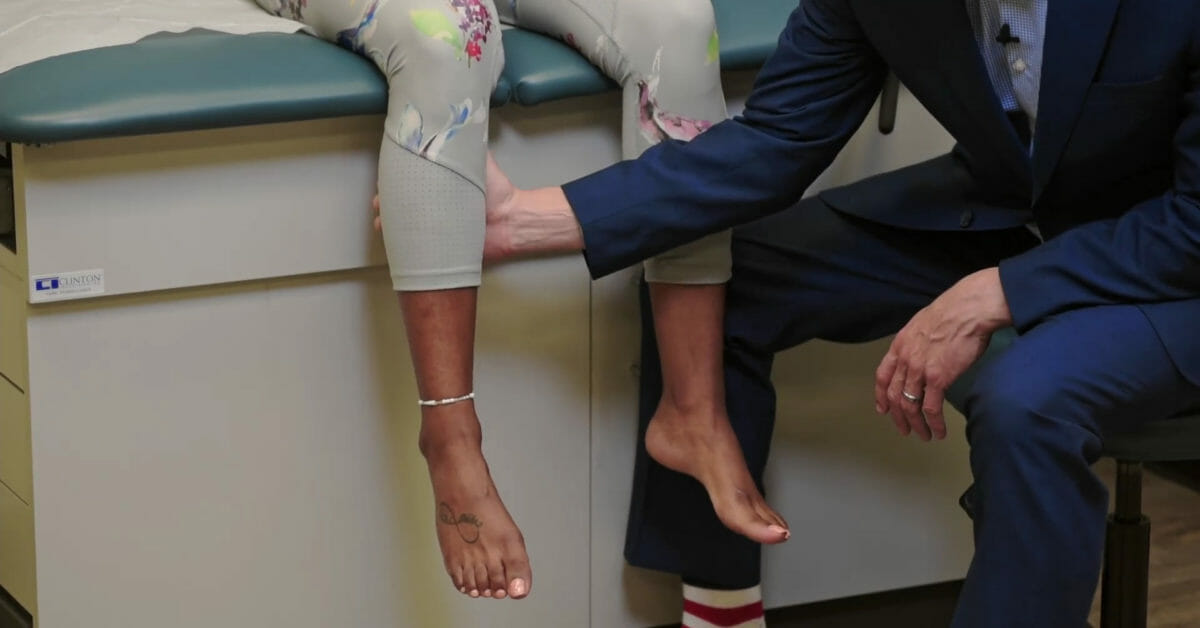
Thompson test for Achilles tendon rupture
Image by Lecturio.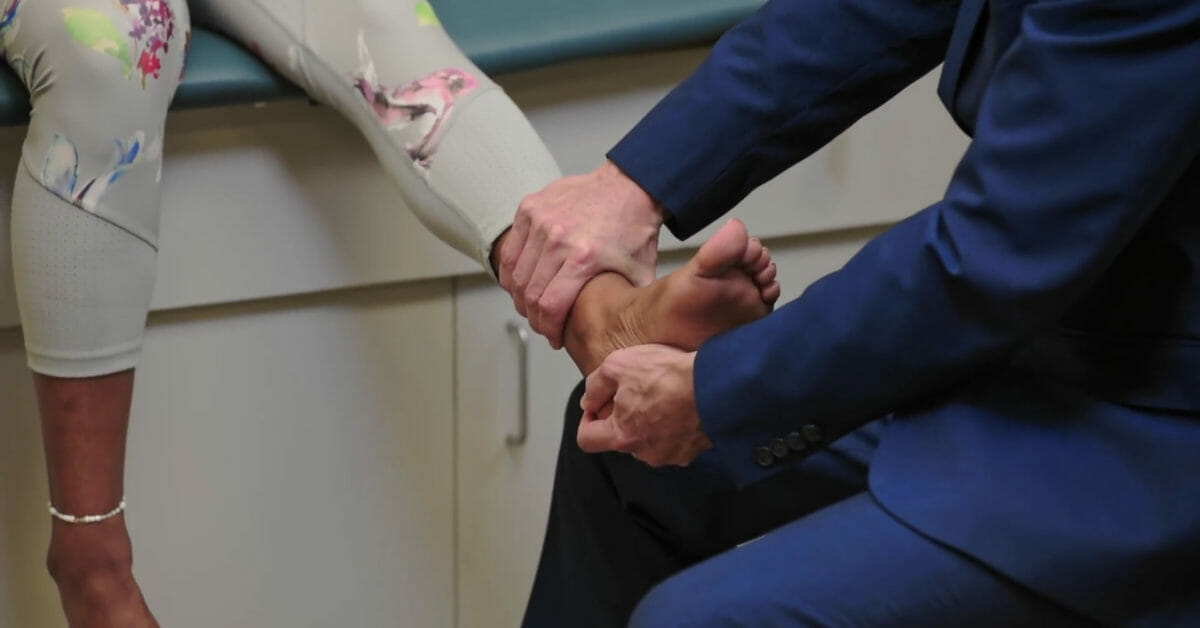
Anterior drawer test of the ankle joint
Image by Lecturio.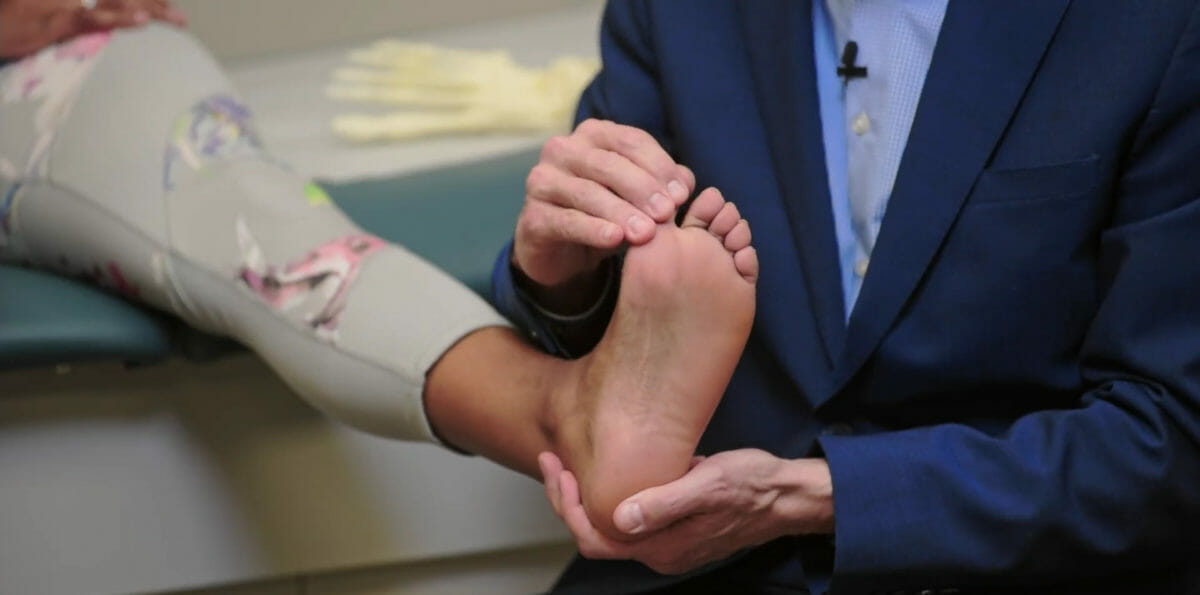
Windlass test:
Pain at the calcaneal attachment of the plantar aponeurosis with passive dorsiflexion of the toes indicates plantar fasciitis.
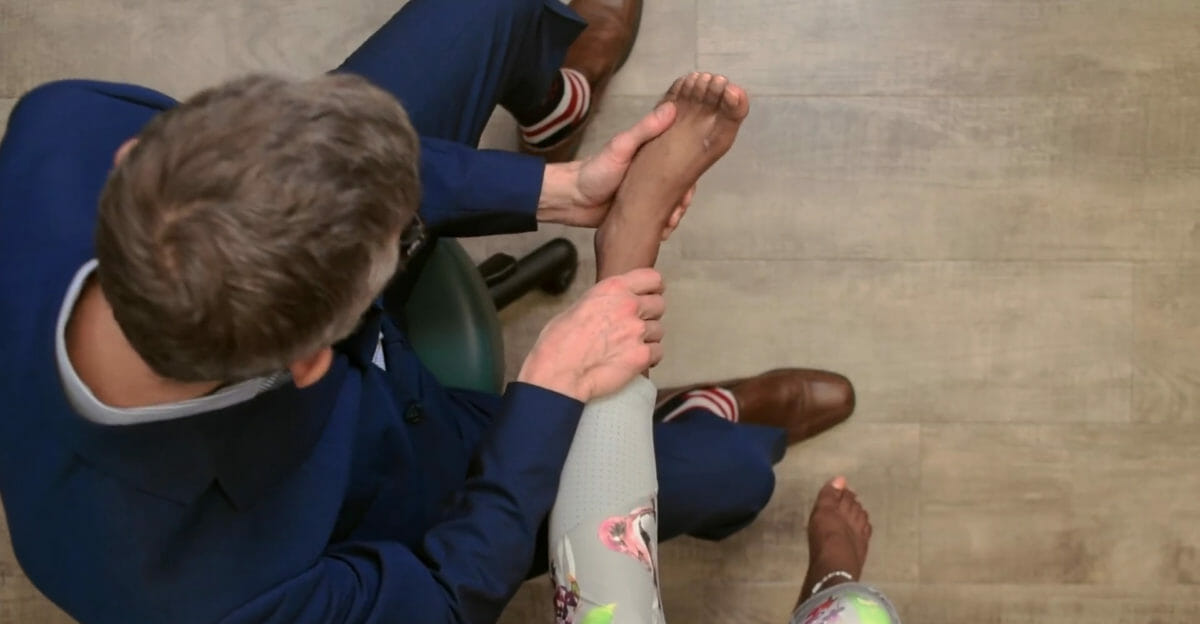
Talar tilt test
Image by Lecturio.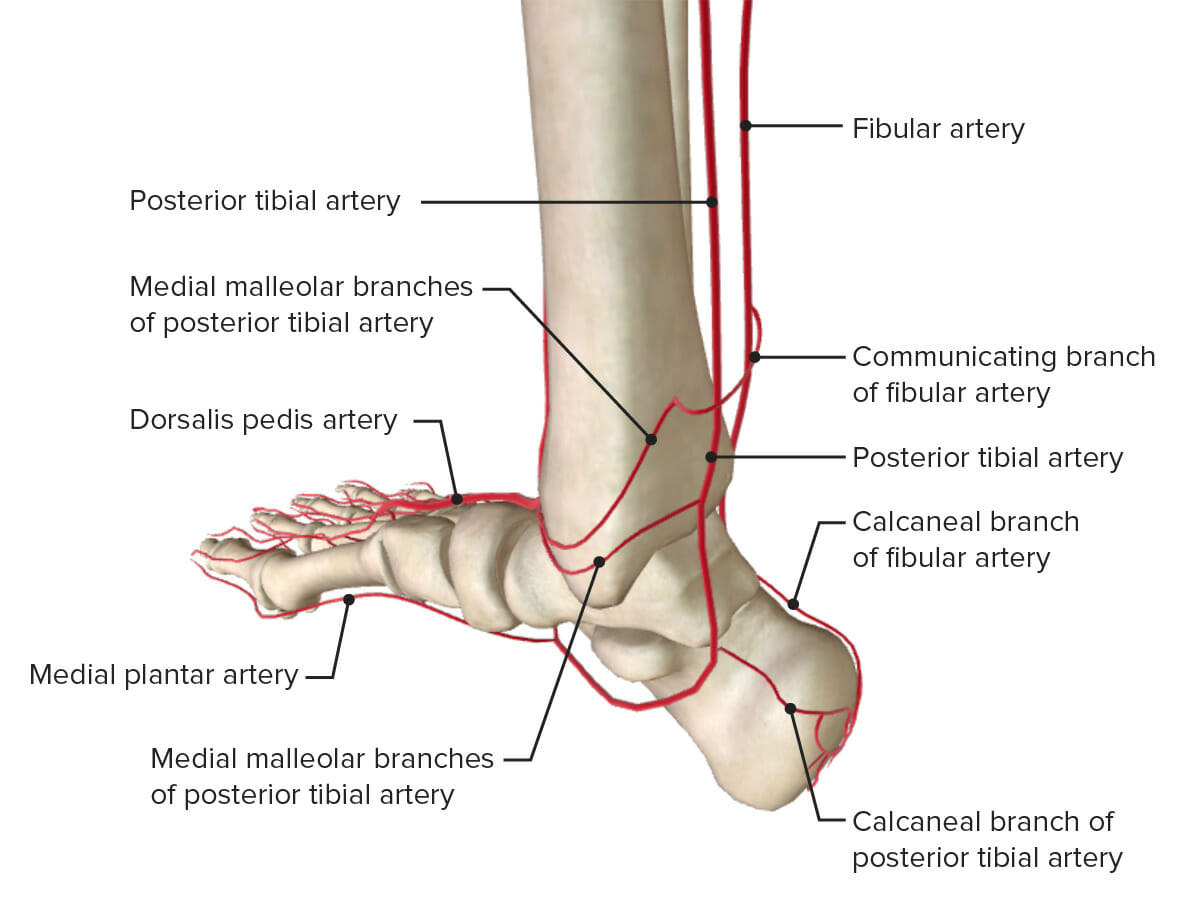
Arterial supply to the ankle:
Note that the anterior tibial artery is shown as its continuation, the dorsalis pedis artery.
| Palpation Palpation Application of fingers with light pressure to the surface of the body to determine consistency of parts beneath in physical diagnosis; includes palpation for determining the outlines of organs. Dermatologic Examination | Effusion | Range of motion Range of motion The distance and direction to which a bone joint can be extended. Range of motion is a function of the condition of the joints, muscles, and connective tissues involved. Joint flexibility can be improved through appropriate muscle strength exercises. Examination of the Upper Limbs | Special tests | |
|---|---|---|---|---|
| Osteoarthritis Osteoarthritis Osteoarthritis (OA) is the most common form of arthritis, and is due to cartilage destruction and changes of the subchondral bone. The risk of developing this disorder increases with age, obesity, and repetitive joint use or trauma. Patients develop gradual joint pain, stiffness lasting < 30 minutes, and decreased range of motion. Osteoarthritis | Osteophytes and tender joint line | +/– | Limited by pain Pain An unpleasant sensation induced by noxious stimuli which are detected by nerve endings of nociceptive neurons. Pain: Types and Pathways | Plain film radiography:
|
| Meniscus tear Meniscus tear The menisci are fibrocartilaginous wedge-shaped structures between the distal femur and proximal tibia that stabilize and dissipate weight-bearing forces at the knee joint. A meniscus tear is an injury to the meniscus caused by rotational or shearing forces across the tibiofemoral joint. Meniscus Tear | Tender joint line | +/– | Locking sensation |
|
| Ligament injuries | Tender joint line | ++ ( ACL ACL A strong ligament of the knee that originates from the posteromedial portion of the lateral condyle of the femur, passes anteriorly and inferiorly between the condyles, and attaches to the depression in front of the intercondylar eminence of the tibia. Knee Joint: Anatomy tears) | Limited by pain and sensation of “give-away” |
|
| Gout Gout Gout is a heterogeneous metabolic disease associated with elevated serum uric acid levels (> 6.8 mg/dL) and abnormal deposits of monosodium urate in tissues. The condition is often familial and is initially characterized by painful, recurring, and usually monoarticular acute arthritis, or “gout flare,” followed later by chronic deforming arthritis. Gout | Warm joint | ++ | Limited by pain Pain An unpleasant sensation induced by noxious stimuli which are detected by nerve endings of nociceptive neurons. Pain: Types and Pathways | Joint aspiration and analysis |
| Pes PES Removal of plasma and replacement with various fluids, e.g., fresh frozen plasma, plasma protein fractions (ppf), albumin preparations, dextran solutions, saline. Used in treatment of autoimmune diseases, immune complex diseases, diseases of excess plasma factors, and other conditions. Thrombotic Thrombocytopenic Purpura anserine bursitis | Point tenderness Point Tenderness Chronic Apophyseal Injury at insertion (2 cm below medial tuberosity) | – | No limitation |
| Palpation Palpation Application of fingers with light pressure to the surface of the body to determine consistency of parts beneath in physical diagnosis; includes palpation for determining the outlines of organs. Dermatologic Examination | Special tests | Notes | |
|---|---|---|---|
| Ankle sprain |
|
Tilt test | Ottawa ankle rules: an ankle
x-ray
X-ray
Penetrating electromagnetic radiation emitted when the inner orbital electrons of an atom are excited and release radiant energy. X-ray wavelengths range from 1 pm to 10 nm. Hard x-rays are the higher energy, shorter wavelength x-rays. Soft x-rays or grenz rays are less energetic and longer in wavelength. The short wavelength end of the x-ray spectrum overlaps the gamma rays wavelength range. The distinction between gamma rays and x-rays is based on their radiation source.
Pulmonary Function Tests is indicated for any of the following:
|
| Plantar fasciitis Plantar fasciitis Inflammation of the plantar fascia (aponeurosis) on the bottom of the foot causing heel pain. The etiology of plantar fasciitis remains controversial but is likely to involve a biomechanical imbalance. Though often presenting along with heel spur, they do not appear to be causally related. Ankle and Foot Pain | Tenderness at the insertion point on the calcaneus Calcaneus The largest of the tarsal bones which is situated at the lower and back part of the foot, forming the heel. Foot: Anatomy (plantar surface) | Windlass test | Loss of arch might be noted |
| Tarsal tunnel syndrome Tarsal tunnel syndrome Entrapment of the distal branches of the posterior tibial nerve (which divides into the medial plantar, lateral plantar, and calcaneal nerves) in the tarsal tunnel, which lies posterior to the internal malleolus and beneath the retinaculum of the flexor muscles of the foot. Symptoms include ankle pain radiating into the foot which tends to be aggravated by walking. Examination may reveal tinel’s sign (radiating pain following nerve percussion) over the tibial nerve at the ankle, weakness and atrophy of the small foot muscles, or loss of sensation in the foot. Ankle and Foot Pain | Palpation Palpation Application of fingers with light pressure to the surface of the body to determine consistency of parts beneath in physical diagnosis; includes palpation for determining the outlines of organs. Dermatologic Examination may reproduce symptoms of tingling Tingling Posterior Cord Syndrome/burning radiating to the soles | Tinel sign | |
| Achilles tendinitis Tendinitis Ankylosing Spondylitis/rupture | Palpating along the tendon may show a gap (rupture) or tenderness at insertion (superior calcaneus Calcaneus The largest of the tarsal bones which is situated at the lower and back part of the foot, forming the heel. Foot: Anatomy). | Thompson test |